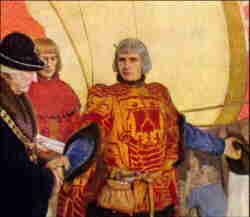 SKC Films Library SKC Films Library |
| SKC Films Library >> American History >> Discovery of America and Early Explorations |
| John Cabot Italian navigator who laid the groundwork for British land claims in Canada
Giovanni Caboto was born in Genoa, Italy, about 1450, the son of a seaman and merchant. His family moved to Venice in 1461. In 1482 he married a Venetian woman, Mattea, with whom he had three sons -- Ludovico, Sebastiano, and Sancio. A merchant like his father, Giovanni traded in spices with the ports of the eastern Mediterranean, and became an expert mariner. Like many other traders of his day, Caboto knew that better profits could be had by all if a sea route to the Orient could be established, thereby cutting out the middlemen of the Middle East. But the Venetians weren't interested in a sea route, since they had a monopoly on trade through the eastern Mediterranean. So, sometime around 1490, Caboto decided to move his family to Valencia, Spain, hoping to gain either Spanish or Portuguese support for an expedition to find such a route. He was too late, however. Thanks to Bartolomeu Dias and Vasco da Gama, Portugal had pioneered a route to India by sailing down the Atlantic coast of Africa, around the Cape of Good Hope, and through the Indian Ocean. In 1493, Christopher Columbus, sailing for Spain, announced that he had reached the Orient by sailing west across the Atlantic. Turned down by both Spain and Portugal, Caboto next turned in 1494 or 1495 to England -- to the merchants of the port of Bristol, where he settled with his family, and to King Henry VII. What he proposed to them was a plan to reach Asia by sailing west across the North Atlantic, which he estimated would be much shorter and quicker than Columbus' southerly route. The merchants of Bristol agreed to support his scheme, and, on March 5, 1496, he received official backing from Henry VII. It may have been about this time that Giovanni Caboto became known as John Cabot, for from this time on he sailed for the English Crown. Cabot made his first voyage in 1496, but was forced to turn back after running short of food, running into bad weather, and having to fend off a mutiny. His 1497 voyage, however, was far more successful. Sailing out of Bristol aboard the Matthew in May, with a crew of about twenty, Cabot steered a course across the North Atlantic. Some 35 days later he sighted land, and by August 6 the Matthew was back in Bristol. This is all that is known about this voyage, however, as no records survive. No one knows for sure exactly how far north or south he may have sailed, where or even if he made landfall in North America, or what he may have found. Although Cabot brought no riches back to England, Henry VII granted him £10, and later a pension of £20 a year. In February 1498, Cabot was authorized to make another voyage, and in May he set sail with a fleet of five vessels. Just as with the 1497 voyage, few details concerning route, landing points, or specific events survive. History does record that one ship returned to Bristol after being damaged in a storm. We also know that the other ships returned to Bristol with more geographical knowledge of the areas now known as Newfoundland and Labrador. Lastly, we know that John Cabot, his son Sancio, and some of his crew died while ashore, but not the specific circumstances of those deaths. Despite the lack of specific information concerning Cabot's voyages and fate, his expeditions proved the existence of a shorter route across the northern Atlantic Ocean, which in turn led to future British voyages to North America. Those voyages in turn allowed Great Britain to claim large tracts of land in what is now Canada. |
| SKC Films Library >> American History >> Discovery of America and Early Explorations This page was last updated on 05/30/2017. |
